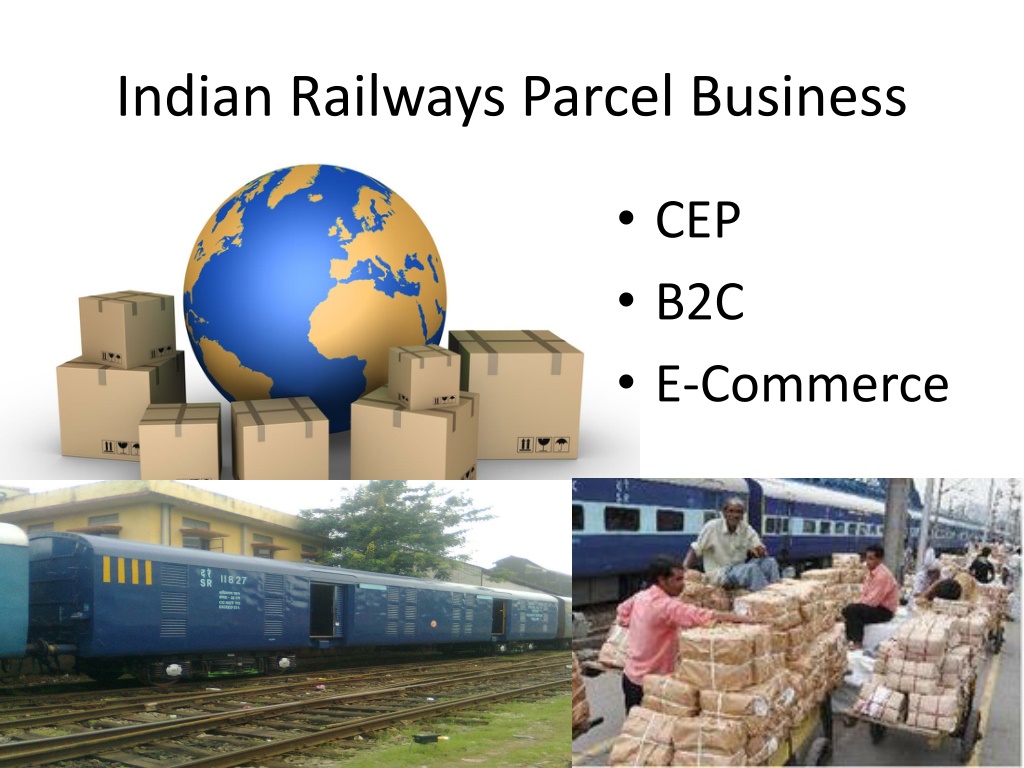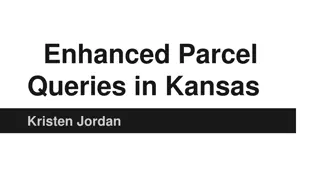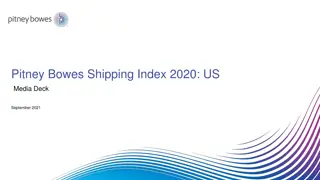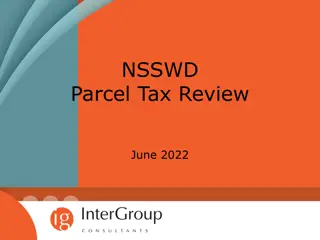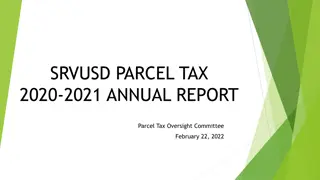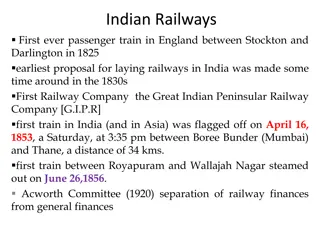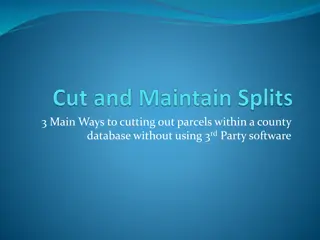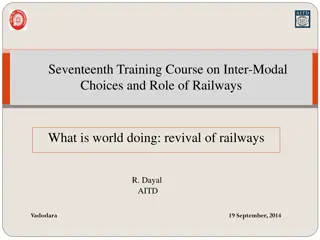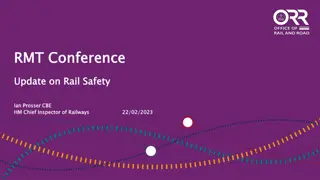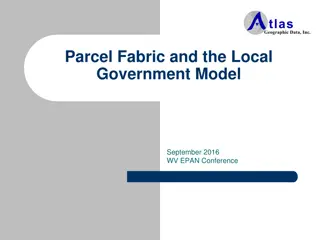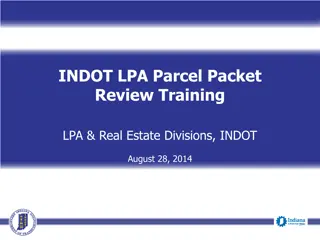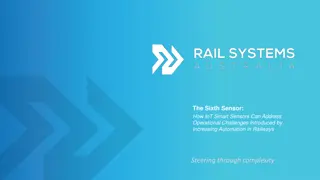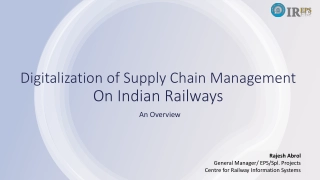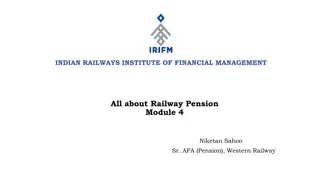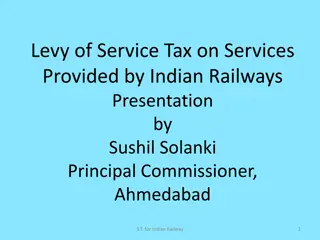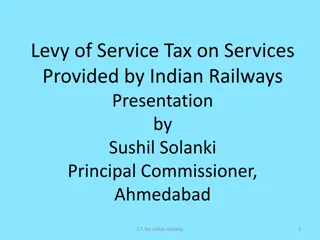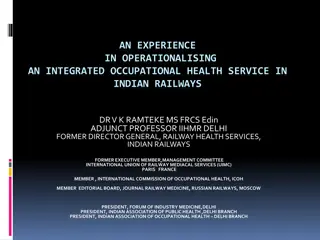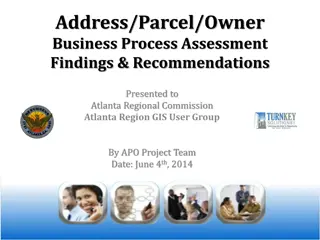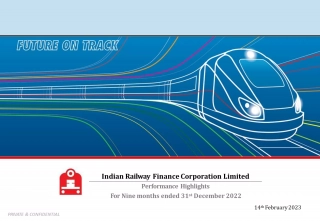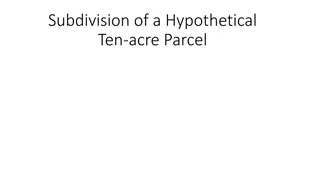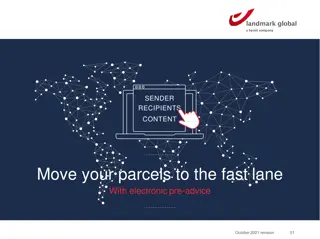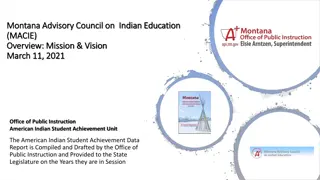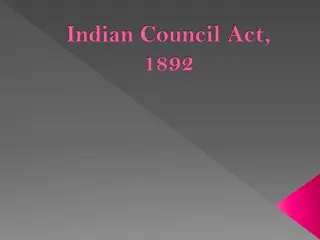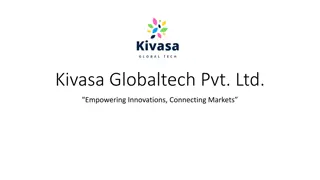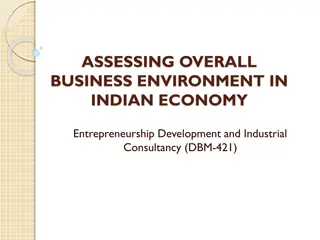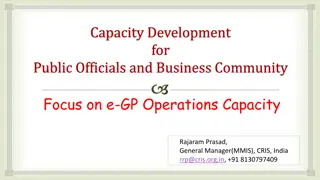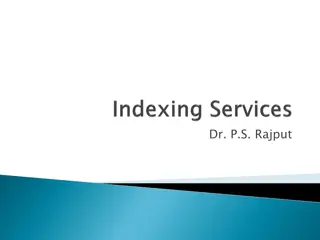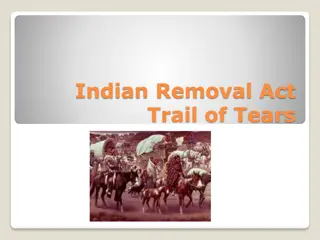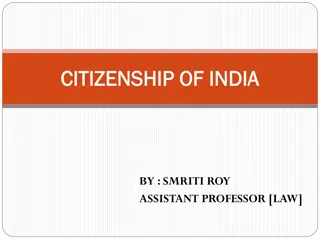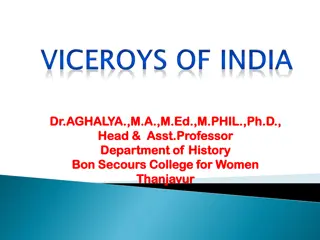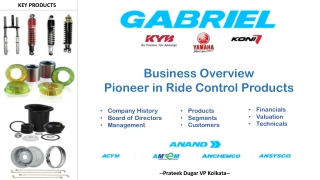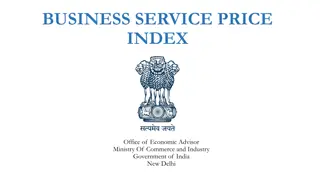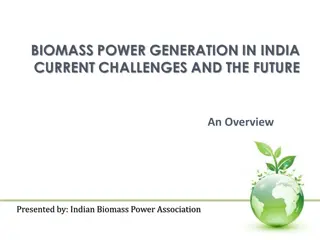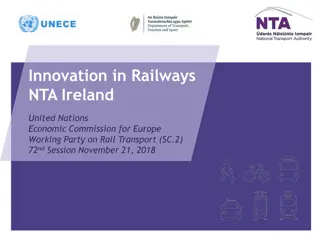Indian Railways Parcel Business Overview
Indian Railways' parcel business within the CEP B2C E-Commerce sector plays a significant role in its earnings, with a substantial amount coming from parcel services in addition to freight. The railways utilize various methods to carry parcels, including specific wagons and dedicated parcel trains. Booking parcels can involve leasing or non-leased options, each presenting its own set of challenges. The implementation of Parcel Management System (PMS) enhances tracking and management capabilities. Additionally, comprehensive policies and schemes regulate parcel leasing and operations within the Indian Railways system.
Download Presentation

Please find below an Image/Link to download the presentation.
The content on the website is provided AS IS for your information and personal use only. It may not be sold, licensed, or shared on other websites without obtaining consent from the author. Download presentation by click this link. If you encounter any issues during the download, it is possible that the publisher has removed the file from their server.
E N D
Presentation Transcript
Indian Railways Parcel Business CEP B2C E-Commerce
Indian Railways Earnings (data are of Year 2016 and approximate) Rs.1,60,000 Cr 65% is Freight 1.2 % is Parcel 90% from Bulk Commodities 5% of Freight earnings from Container traffic
How do Indian Railways carry Parcels? Assistant Guard Cabins (AGC) Brake Vans (SLRs) Parcel Vans (VPU/VPH) Special Parcel Trains Freight Wagons (BCN) Special Wagons (Milk Tank) Refrigerated Wagons/Coaches
Booking of Parcels Non-Leased Leased
Non-Leased Parcel: Concerns Manual handling Pallet and Container solutions ? Non-availability of space Over-carriage Prior information Segregation for OD Damage during transit
Parcel Management System (PMS) Parcel Management system is implementation of IT and computerizing the work of Booking, Loading, Unloading, tracking, tracing, delivery and internet based enquiry. As per the main features of parcel management system, booking, weighment and cash payment can be done on single window. The use of technologies like Bar-coding and tracking facility improves the management of parcel traffic. Customer can track their parcel through Parcel and Luggage Tracking online system available on website address www.parcel.indianrail.gov.in. http://www.indianrailways.gov.in/railwayboard/uploads/dir ectorate/cis/downloads/ParcelManagementSystem.pdf
Comprehensive Parcel Leasing Policy, 2014 http://www.indianrailways.gov.in/railwayboar d/uploads/directorate/traffic_comm/Frght_M ktg_2k14/FM_06_2014.pdf http://www.indianrailways.gov.in/railwayboar d/uploads/directorate/traffic_comm/Freight_ Marketting_2016/FM_Draft_140116.pdf
Special Parcel Train Operator (SPTO) Scheme http://www.indianrailways.gov.in/railwayboard/ uploads/directorate/traffic_comm/Frght_Mkt g_2k14/FM_23_14.pdf
Policy on Leased Parcel Cargo Express, 2007, 2016 http://www.indianrailways.gov.in/railwayboard/ uploads/directorate/traffic_comm/Freight_M arketting_2016/FM_140116.pdf
Parcel rates http://www.indianrailways.gov.in/railwayboard/ view_section.jsp?lang=0&id=0,6,335
Indian Railways: Scales of Parcel Rates Scale Rate (Rs.) for 1-10 Kg for 1-50 Km Rate (Rs.) for 1-10 Kg 51-60 Km LUGGAGE (L) 4.43 5.06 RAJDHANI (R) 3.93 4.22 PARCEL (P) 2.10 2.25 STANDARD (S) 1.31 1.41
Rates Comparison Railways cargo is almost 50% cheaper than air-cargo & 90% of the existing online orders are currently being shipped via air- cargo!
Parcel Earning Projections Year Earnings (Crores) 1827.6 % growth 2013-14 11.7% 2014-15 2002.23 10.0% E-tail business is growing at over 50% per annum. IR s Parcel Business is incurring LOSSES!
Morgan Stanley Research, 2015 The World Bank estimates that India's logistics costs are 2-3x the best practice benchmark costs, hurting India's manufacturing competitiveness. We believe that the key reason for this is the underinvestment in Indian Railways with budget allocation vs. roads significantly lower than global standards. Rail is a significantly cheaper mode of transport than roads, yet the share of roads in Indian freight movement is >1.5x that of the railways, owing to the congestion on the rail network and poor policies http://www.indianrailways.gov.in/Morgan%20Stanley% 20Report%20on%20Indian%20Railways.pdf
Indian Railways:White Paper, 2015 http://www.indianrailways.gov.in/railwayboar d/uploads/directorate/finance_budget/Budge t_2015-16/White_Paper-_English.pdf
Excerpts of Indian Railways Budget 2016-17 104. Non-Fare Revenues: e. Overhaul of Parcel business: We plan to liberalize the current parcel policies including opening the sector to container train operators to effect a quantum jump in IR s share of the national CEP (Courier, Express and Parcel) market. Door to door connectivity is especially important for this market segment and we will take all steps necessary to expand our service offerings specially to growing sectors such as e-commerce. We will also initiate a pilot project for online booking of parcels.
Excerpts of Indian Railways Budget 2016-17 Tariff rationalisation 99.The current tariff structure of IR has led to out-pricing of our services in the freight market. A review of tariff policy will be undertaken to evolve a competitive rate structure vis a vis other modes, permit multi-point loading/unloading and apply differentiated tariffs to increase utilization of alternate routes. The possibility of signing long term tariff contracts with our key freight customers using pre-determined price escalation principles will be explored which would provide predictability of revenues to IR and of costs to our customers.
Excerpts of Indian Railways Budget 2016-17 Building terminal capacity 100. Inadequacy of warehousing and transportation facilities is also one of the causes that that keep potential customers away from Page 31 of 46 the Railways. In order to complete the chain of transportation, it is proposed to develop Rail side logistics parks and warehousing. These logistic parks and warehouses would be created in PPP mode to bring the required efficiency and investment but also help attract greater traffic to the Railways. With the coming in of TRANSLOC, the Transport Logistics Company of India, we will be witness to a paradigm shift in our role as a national logistics provider. The focus will be on providing last mile connectivity for freight business and significant reduction in logistic costs. At least 10 goods sheds will be developed by TRANSLOC in 2016-17. To capture the automobile traffic, we will soon inaugurate India s first rail auto hub in Chennai.
Excerpts of Indian Railways Budget 2016-17 101. This push on rail side warehousing would also encourage development of cold storage facilities on vacant land near freight terminals. Local farmers and fisherman would be given preferential usage of the facility. A policy in this regard would be issued in the next 3 months.
CEP (Courier, Express, Parcel) Urgent, high value low volume, time sensitive, perishable Bottom line: Fast and reliable delivery Small packages: 50-70 Kg International (steady) and Domestic (Hike) markets Traditionally B2B; now also B2C and C2C Logistics pattern: first mile, line haul, last mile Role of e-commerce
Liked by Stakeholders Railways would extend logistic support to various ecommerce providing designated pick-up centres at identified stations. companies by (Hon ble Minister for Railways, 2014)
CEP Global CEP market at CAGR of 3.42 % in 2014- 19 (technavio s forcast) CEP Market: Driver Domestic E-Commerce business Challenge Competition in Market Trend Rise of Inter-modal logistics
New Start ups Pickrr Shipsy Parcelled Daak Ninja Ship Tickr Pigen
E-Commerce Global B2C sales: $1.7 trillion (2015) $2.3 trillion (2018) Annual growth rate = around 15% Asia-pacific and China with India emerging fast India s market - $100 billion by 2020 (Golden Sachs) Leading ones: Flipcart, Amazon, Snapdeal
Why E-Commerce? Many benefits Many players New operation pattern Reverse logistics 3PL and more The global 3PL market reached $750 billion in 2014, and grew to $157 billion in the US; demand growth for 3PL services in the US (7.4% YoY) outpaced the growth of the US economy in 2014. As of 2014, 80 percent of all Furtune 500 companies and 96 of the Fortune 100 used some form of 3PL services. (source: Wikipedia)
With e-commerce push, India Post parcel revenue soars 37% (PTI Jul 12, 2015, 03.51PM IST) (As part of initiatives to leverage the e-commerce sector, India Post has forged tie ups with Snapdeal, Amazon, Paytm and Yepme for parcel delivery.)
Relevance of e-Commerce to Railways e-commerce business by 2020 will be $100 Billion (from $2.9billion in 2013) as per Morgan Stanley report. e-Tail which involve transportation of goods constitute about 6% of e commerce business. Logistics component of value is about 10%. Core competence of Railways is Transportation IR s parcel business at present is about Rs2000 Cr. Railway Needs to Claim its Share (source: AMP Project/NAIR)
SWOT: Railways as Logistics Solution to e-Commerce: Strengths Established transporter Daily interaction with about 25 million customers Railway can be easy pick up & delivery points at Stations Established Railway PSUs like ITRCTC (already doing e-Commerce), CONCOR Wide pan India presence Bulk movement of goods for B2B commerce Connectivity with the hinterland and smaller business hubs Cost effective & speedy long distance transportation Located in business hubs in most cities Unrestricted interstate movement of goods (source: AMP Project/NAIR)
SWOT Analysis: Weaknesses Centralization of business related decision-making. Poor quality of customer interface at the booking points No assured service of safe delivery of consignments Poor handling of goods at loading and unloading points Inadequate terminal facilities like warehousing, stacking etc. Lack of long term partnership with potential customers No monitoring or tracking system of consignments Theft of goods and lack of security at terminals Tardy and lengthy process of settlements of claims Limitations in availability and customization of rolling stock (source: AMP Project/NAIR)
SWOT Analysis: Opportunity High growth rate of e-commerce or e-tailing in India Low cost of entering e-Commerce Poor condition of roads in the hinterlands Limited capacity of airline cargo Expansion of e-tailing in Tier-2 and Tier-3 cities where Railways has good connectivity Bulk movement of goods booked by e-commerce companies (source: AMP Project/NAIR)
SWOT Analysis: Threats Loss of traffic to other modes of transport through e-Commerce Cost effective road transport End to end delivery by Road transport Expansion and improvement of road network Preference of e-commerce companies for other mode of transport Government Regulations (source: AMP Project/NAIR)
Business e-Commerce options for Railways Model 1: (Business as usual) Limited Logistics solution to e- Commerce Web portal for booking of vehicles/ warehousing space to be operated by IR. Transportation + temporary storage (Warehousing) by Railways Front & Back end logistics like transportation from supplier of goods upto warehouse by e-Commerce companies Warehousing at origin & destination by company (source: AMP Project/NAIR)
Model-1: Limited Logistic Solution Long term agreement between IR & e-Commerce company for assured supply of vehicles & traffic respectively Handling at loading and unloading points to be responsibility of e-commerce companies Safety & security of goods during handling at loading & unloading points shall be responsibility of e-commerce companies IR shall allocate space on SLRs/Lease VPUs (source: AMP Project/NAIR)
Model-1:Limited Logistics Solution M A N U F A C T U R E R S T E R M I N A L - D T E R M I N A L - O W A R E H O U S E W A R E H O U S E C U S T O M E R S (source: AMP Project/NAIR)
Limitations of model -1 Mainly addresses the transportation aspect and not the complete logistics issue. Substantial quantum of traffic especially the long distance e-Commerce traffic already being carried by IR thus may not lead to net increase in traffic volumes Conservative approach to business which may not provide adequate opportunity to increase IR s business. Does not harnesses the available strengths of IR in form of PSUs with competence in e-Commerce and complete logistics. (source: AMP Project/NAIR)
Model 2: Business Option- Railways entry into e Commerce So far IR unable to attain expected growth in parcel business. IRCTC already in e- Commerce CONCOR already providing complete logistics solution for many companies IR CONCOR IRCTC (source: AMP Project/NAIR)
Model 2: Creating Synergies IR can offload parcel business to IRCTC who in partnership with CONCOR can engage in e-Commerce business JV between IRCTC & CONCOR with equity participation of IR. IR CONCOR IRCTC (source: AMP Project/NAIR)
Model-2: Creating Synergies contd. JV to have full freedom to make all business decisions JV to have obligation to pay dividend to IR JV shall operate all components of e-Commerce viz selling of goods through web portal, provide logistics, banking transactions The e-Commerce entity shall also utilise existing warehouses of CONCOR or develop new warehouses. It would also provide necessary insurance and compensation of the goods to the customers in case of damage and non-delivery (source: AMP Project/NAIR)
Points to appreciate Railways is uniquely placed in the transportation and logistics business Railways is reasonable charge-wise and otherwise too Railways have wide network and connectivity Railways do business too Railways need to realize its role as a key link of the whole logistics chain
